
Sizes and Scales: Beavers are the second largest rodents, after the capybara. Beavers continue to grow throughout life. Adult specimens weighing over 25 kg (55 lb) are not uncommon. Females are as large as or larger than males of the same age, which is uncommon among mammals.
Social animals: Beavers build dams of mud and of the stems and boughs of trees felled by their powerful incisor teeth. Their homes are called "lodges," and are roomy chambers, with entrences beneath the water. The mud is plastered down by the fore-feet, and not, as often supposed, by the tail, which is employed solely as a rudder.
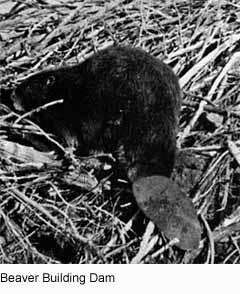 Landscape Shapers Supreme: Beavers work as a keystone species in an ecosystem by creating wetlands that are utilized by many other species. The ability of beavers to radically alter landscape is amazing. Next to humans, no other living animal does more to shape its landscape. Introduced to an area without its natural predators, as in Tierra del Fuego, beavers have flooded thousands of acres of land and are considered an unstoppable plague. Landscape Shapers Supreme: Beavers work as a keystone species in an ecosystem by creating wetlands that are utilized by many other species. The ability of beavers to radically alter landscape is amazing. Next to humans, no other living animal does more to shape its landscape. Introduced to an area without its natural predators, as in Tierra del Fuego, beavers have flooded thousands of acres of land and are considered an unstoppable plague.
Dam: good builders... The dams are created both as a protection against predators, e.g., coyotes, wolves and bears, and to provide food storage during winter. The sound of water in motion and the current stimulates the beavers to build. If, for example, a pipe is placed under the dam to drain it, the beavers may stuff it with a tree trunk unless the pipe inlet is protected with a large cage-like filter. They may repair any damage to the dam and build it higher as long as the sound continues. However, in times of high water, they often allow spillways in the dam to flow freely. Beavers are even known to build dams in response to recordings of water flowing.
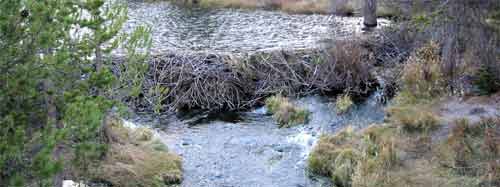
Careful! Destroying a beaver dam without removing the beavers takes a lot of effort, especially if the dam is downstream of an active lodge. Beavers can rebuild such primary dams overnight, but may not defend secondary dams as vigorously.
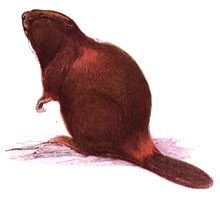 Bothersome Beavers: Beaver dams can be disruptive; the flooding can cause extensive property damage, and when the flooding occurs next to a railroad roadbed, it can cause derailments by washing-out under the tracks. In addition, when a beaver dam bursts it can result in a dangerous flash flood!. This disruption is not limited to human geography; beavers can destroy nesting habitat for endangered species, and often destroy mature trees for which they have no use. Bothersome Beavers: Beaver dams can be disruptive; the flooding can cause extensive property damage, and when the flooding occurs next to a railroad roadbed, it can cause derailments by washing-out under the tracks. In addition, when a beaver dam bursts it can result in a dangerous flash flood!. This disruption is not limited to human geography; beavers can destroy nesting habitat for endangered species, and often destroy mature trees for which they have no use.
Wetlands Restoration: Even still, dam building activity restores wetlands, the land's most beneficial ecosystem. Wetland benefits include flood control downstream, biodiversity (by providing habitat for many rare as well as common species), and water cleansing, both by the breakdown of toxins such as pesticides and the retention of silt by beaver dams. The latter also reduces erosion as well as decreasing turbidity that is the limiting factor for aquatic life. The beaver's effects on the environment go beyond what you would expect of a rotund, buck toothed rodent. The first part of his influence is felt when his dam creates a pond.
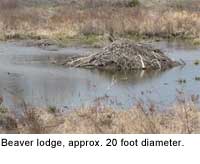 Love Those Lodges: The ponds created by well-maintained dams help isolate the beavers' home, their lodge. The lodge has underwater entrances to make entry nearly impossible for any other animal (however, muskrats have been seen living inside beaver lodges with the beavers who made it). A very small portion of the lodge is actually used as a living area. Contrary to popular belief, beavers actually dig out their den with an underwater entrance after they finish building the dam and lodge structure. There are typically two dens within the lodge, one for drying off after exiting the water, and another, drier one where the family actually lives. Love Those Lodges: The ponds created by well-maintained dams help isolate the beavers' home, their lodge. The lodge has underwater entrances to make entry nearly impossible for any other animal (however, muskrats have been seen living inside beaver lodges with the beavers who made it). A very small portion of the lodge is actually used as a living area. Contrary to popular belief, beavers actually dig out their den with an underwater entrance after they finish building the dam and lodge structure. There are typically two dens within the lodge, one for drying off after exiting the water, and another, drier one where the family actually lives.
Lily Lovers: The American beaver's favorite food is the water-lily, which bears a resemblance to a cabbage-stalk, and grows at the bottom of lakes and rivers. Beavers also gnaw the bark of birch, poplar and willow trees; but during the summer a more varied herbage, with the addition of berries, is consumed.
Danger Signal: When startled or frightened, a swimming beaver will rapidly dive while forcefully slapping the water with its broad tail. This creates a loud 'slap', audible over large distances above and below water. This noise serves as a warning to other beavers in the area. Once a beaver has made this danger signal, all nearby beavers will dive and may not reemerge for some time.
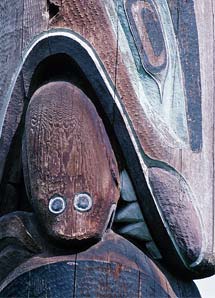 Fur Trade: Beaver pelts were used for barter by Native Americans in the 17th century to gain European goods. They were then shipped back to Great Britain and France where they were made into clothing items. Widespread hunting and trapping of beavers led to their endangerment. Fur Trade: Beaver pelts were used for barter by Native Americans in the 17th century to gain European goods. They were then shipped back to Great Britain and France where they were made into clothing items. Widespread hunting and trapping of beavers led to their endangerment.
Eventually, the fur trade fell apart due to declining demand in Europe and the takeover of trapping grounds to support the growing agriculture sector. A small resurgence in beaver trapping has occurred in some areas where there is an over-population of beaver; trapping is only done when the fur is of value, and normally the remainder of the animal is also utilized as animal feed.

Beavers on the Comeback: The European Beaver (Castor fiber) was hunted almost to extinction in Europe, both for fur, and for castoreum, a secretion of its scent gland believed to have medicinal properties.
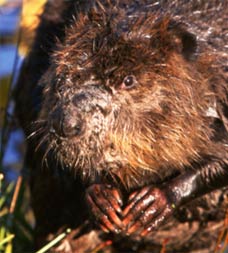 However, the beaver is now being re-introduced throughout Europe. Several thousands live on the Elbe, the Rhone and in parts of Scandinavia. In northeast Poland there is a thriving community of Castor fiber. They have been reintroduced in Bavaria and the Netherlands and are tending to spread to new locations. However, the beaver is now being re-introduced throughout Europe. Several thousands live on the Elbe, the Rhone and in parts of Scandinavia. In northeast Poland there is a thriving community of Castor fiber. They have been reintroduced in Bavaria and the Netherlands and are tending to spread to new locations.
British Beavers: The beaver finally became extinct in Great Britain in the sixteenth century: Giraldus Cambrensis reported in 1188 (Itinerarium ii.iii) that it was to be found only in the Teifi in Wales and in one river in Scotland, though his observations are clearly first hand.
In October 2005, six European beavers were re-introduced to Britain in Lower Mill Estate in Gloucestershire, and there are plans for re-introductions in Scotland and Wales.
North American Giant Beaver: The extinct North American Giant beaver (Castoroides ohioensis) was one of largest rodents that ever evolved. It disappeared, with other large mammals in the Holocene extinction event, about 10,000 years ago.
All text is available under the terms
of the GNU Free Documentation License
|